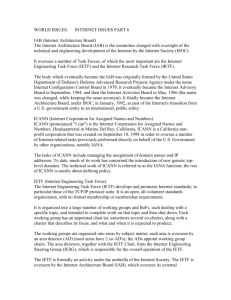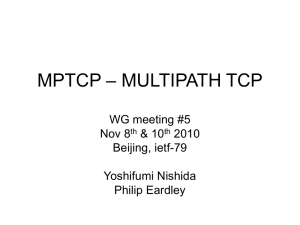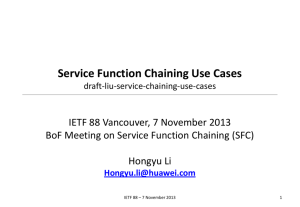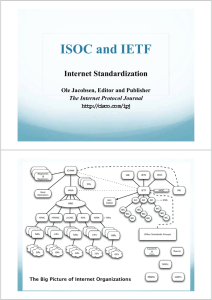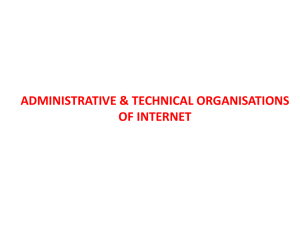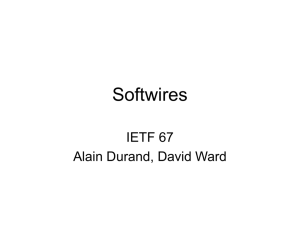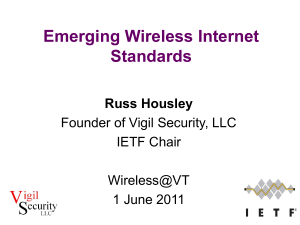IETF - Labs
advertisement
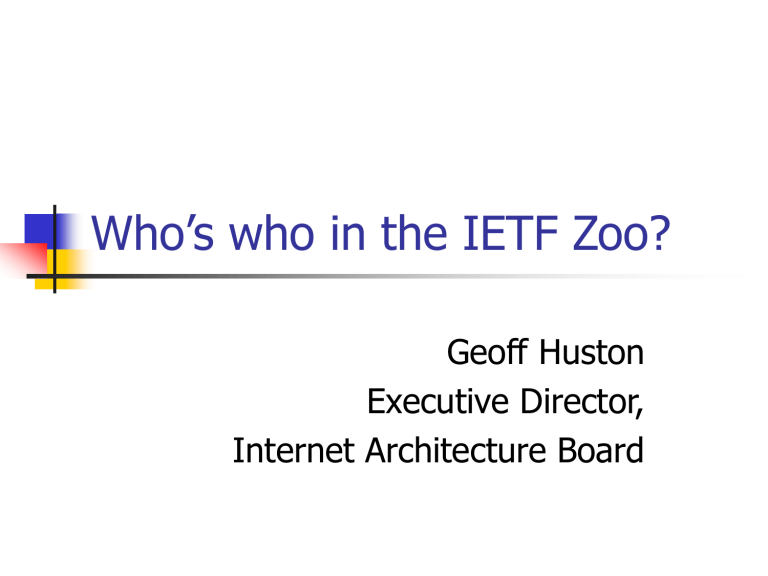
Who’s who in the IETF Zoo? Geoff Huston Executive Director, Internet Architecture Board The IETF is…. The Internet Engineering Task Force is a standards body that supports the development of open standards in support of the Internet The IETF is not like other industry-based standards bodies… The IETF is an open collaborative effort undertaken by a number of groups and individuals, each undertaking particular roles within the overall IETF framework The IETF uses individual contributions and a process of the development of rough consensus to achieve interoperable relevant technical specifications of Internet technologies Players in the IETF Internet Society IETF IAB IESG ICANN ISI IRTF RIRs CNRI Areas Working Groups Research Groups Individuals Research & Academia Industry Roles and Relationships Internet Society IETF IAB IESG ICANN ISI IANA RFC Editor RIRs IRTF Areas CNRI Secretariat Services Working Groups Research Groups Individuals Research & Academia Industry Roles and Relationships Internet Society ISOC funds the RFC Editor ISOC holds the copyright on IETF documents, point of process appeal IETF ISOC charters the IAB IAB IAB charters the IETF IANA IAB confirms IESG members IAB charters the RFC Editor IAB charters the IRTF ICANN ISI IANA RFC Editor IRTF IESG IESG is composed of IETF Area Directors Areas CNRI Secretariat Services Areas are structured into Working Groups Liaison activity between RIRs and IETF RIRs IESG Secretariat Working Groups Research Groups Individuals Research & Academia Industry Confused? But of course! The IETF is not a single organization, it’s a collective illusion! The IETF Is an unincorporated activity that operates under the auspices of the Internet Society The IETF has a Chair (Harald Alvestrand) a Secretariat (undertaken by CNRI) an operational managerial group (the IESG) an architectural and external relationship group (the IAB) A codified set of principles (‘tao’) and a set of operational procedures The IETF does not have members a budget incorporation documents bylaws The IETF Produces Internet Standards Documents (RFCs) that are intended to assist in making the Internet work Is organized into ‘Areas’ managed by ‘Area Directors’ that contain ‘Working Groups’ who work under the terms of a defined charter to produce documents (RFCs) that describe interoperable Internet technologies using an open process of peer review and rough consensus The objective of the IETF is an efficient process that produces high quality descriptions of standard technologies that are relevant, useful and support interoperable implementations that makes the Internet work IETF Areas Applications Transport Yes, security! Operations and Management Routing protocols and services Security IP level services Routing End-to-end transport services Internet Selected applications and application support infrastructure Operational services and Network Management tools General The operation of the IETF itself The Internet Engineering Steering Group Is the group of 13 Area Directors Manages the operation of the Internet Standards Process Recommends the publication of IETF RFC documents Approves Working Group formation and Working Group charters Oversees the general operations of the IETF Internet Standards Process The Internet Architecture Board Is a group of 12 IETF participants Provides architectural comment to the IETF community Manages external relationships to the IETF Oversees the operation of the RFC Editor Provides advice to the IESG on Working Group formation and rechartering The IAB attempts to provide an overall perspective of “making the Internet work” in relation to IETF activities The Internet Society Is a membership society intended to support the development of the Internet Has a Board of Trustees, corporate members, individual members, chapters and a secretariat Is funded through corporate sponsorship and through the operation of subsidiary activity of the .org registry Supports the IETF mission through Funding contributions to the IETF Funding the RFC publication process Providing liability coverage to IETF particpants Entering into contracts for the IETF What ‘defines’ the IETF? Openness Quality Open membership and an culture of inclusion Open operation of the standards development process Consistent objective to create high quality outcomes Competency The capability of core competencies of knowledge as to _why_ the Internet technology is defined in the way it is and where the intricate inter-dependencies are lurking Tribal Culture An enthusiasm to continue to explore refinements and extensions to the Internet technology base My IETF role….. Executive Director of the IAB Provide organizational support to the IAB As a member of the IAB I work on IAB architectural issues, including: QoS architectures Inter-domain routing IPv6 architecture Identities and Locators Operations DNS …… Questions? CNRI Operates the IETF Secretariat Publication of Internet Drafts Operation of IETF meetings Publication of meeting proceedings Provision of support to Working Groups Support of the IESG activities Supports IETF services (web site, mailing lists, draft tracker, etc) The IETF Secretariat operation is funded through IETF meeting attendance fees ISI Operates the RFC Editor function Publishes RFC documents that are the outcome of the Internet Standards Process Publishes (some) RFC documents that have been submitted directly to the RFC Editor Is funded by ISOC Operates with some independent discretion in terms of editorial policies for non-IETF document publication Not all RFCs are IETF Standards! ICANN Operates the Internet Assigned Numbers Authority (IANA) IANA maintains a collection of IETF protocol parameter registries IP addresses, bootp option code points….. Supports the consistent and unique use of protocol parameter code points within the Internet Supports the registration of code points in IETF protocol registries The IANA function is funded by ICANN The RIRs Distribute Internet Number Resources to IP Service Providers Number resources are IP addresses and AS numbers Distributes resources according to defined IETF standards Provides resources on the basis of demonstrated need
